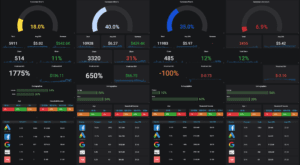I meet all sorts of companies interested in what we are doing and it’s interesting the kinds of discussions. I talk about how we can improve the ROI of marketing and get some interest from a marketer. Then I do a few minutes of research on their company to learn a little more.
They aren’t ready for AI – they are missing the fundamental foundation – a marketing strategy.
In tech, we use a phrase regularly – garbage in garbage out.
To me it’s amazing how many companies do ‘marketing’ without evaluating the value of the content and without measuring and understanding the leads they get out of it. Adwords is generally not the issue here – people click on your ad and convert (or don’t) and you will get leads or change the campaign.
What I’m referring to is really social media marketing. I see it all the time with other companies – a Reddit post that says “How are you using chatbots” with some awkward and fake attempt to get a conversation going (or Tweet or LinkedIn post, or Facebook post – insert your favorite social media platform here.)
No amount of AI will help you if your content and strategy sucks. All it can do is tell you that it does, indeed, suck and give you the data to prove it. It doesn’t give you the tools to fix it.
A strategy works best when you can actually measure the results.
Marketing is about experimentation. It’s about trying new things and seeing what sticks and continually evolving your content and call-to-action to reach and engage more of your best customers. It’s about multi-channel communication that is geared for the type of content needed that that platform.
AI is about measuring and predicting. It’s about quickly identifying what’s working and predicting the next step to help get a customer to move down the funnel. To predict the future, you need the past results.
If you have a marketing strategy, what AI & Analytics can provide is insights into the nuances into your campaigns and content strategy. If I change this audience, remove this keyword, what are the results? If I create content based on these types of keywords, does it attract customers in my target market? How can I use new tools like chatbots to drive leads and conversions? Once I get a lead, what’s the best call to action to get them to convert?
What if I don’t have a strategy?
That’s ok if you don’t have a strategy. A strategy works best when you can actually measure the results. However, you do need to pick one. The book Traction by Gabriel Weinberg (a fantastic summary is available on Medium) recommends choosing two marketing strategies, whether that’s ads and content or SEO and PR, it doesn’t matter. The key is to start somewhere. What gets measured gets managed.
What’s most important is tracking which sources are creating click-through and conversions. Our SEO and Segment Reports can help with this (sorry – shameless self-promotion here.) As you create ads, content, email campaigns or whatever floats your boat, the best way to track this is using UTM parameters which are supported by pretty much every website analytics system.
The challenge with UTM parameters is that the parameters are the same, even as the link is shared (for example if you post your link on Facebook with a utm_source=Facebook, if the link is shared on Twitter that same source will be provided, even though the source is Twitter, not Facebook.)
What we recommend is generating unique a UTM code that represent the combination of UTM parameters, then you can follow the traffic. You’ll know if the originating post was on LinkedIn but the current lead came in from Twitter.
If you aren’t tracking, then you can’t improve.
When defining your strategy it’s important to define what KPIs measure success. (Note that a KPI needs to be ‘realistic’, we’d all love to get leads for free. See our related article How KPIs Create Great Digital Marketers for more info on this topic. The KPIs depend on the strategy.
For SEO KPIs, track page views, bounces, conversions and engagement. For Ad Campaign KPIs track audience, terms, and Cost Per Acquisition. You can see our Marketing Matrix for more information on the data to track at which stage of the funnel.
Having a strategy combined with KPIs to measure execution is really the first step to make sure the strategy works. From there, it’s about leveraging your data to determine how you can improve the execution and if it’s working. The most important asset that any company has is their data and it’s shocking how under-utilized this asset is. Data is the one thing required to identify patterns of what’s working and what’s not. Without it, you are just guessing and hoping what you are doing works.








